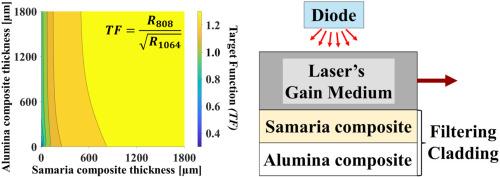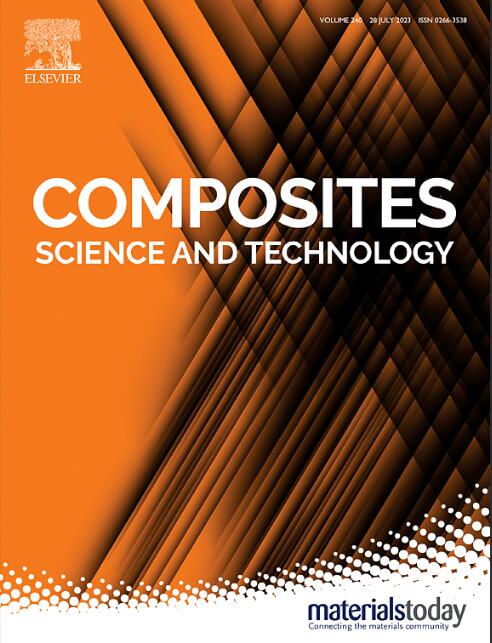用于选择性频率过滤的聚合物复合包层:实验和建模研究
IF 9.8
1区 材料科学
Q1 MATERIALS SCIENCE, COMPOSITES
引用次数: 0
摘要
目前,激光选择性频率滤波是在激光棒周围使用昂贵、沉重和笨重(厚度为毫米)的陶瓷复合包层来实现的,这限制了激光的小型化和可运输性。包层会吸收不需要的自发辐射,并反射 "泵浦 "二极管所需的波长。作为二极管泵浦固态 Nd:YAG 激光棒包层的改进替代品,我们研究了一种喷涂聚合物复合包层(厚度为微米)。与传统的陶瓷复合包层相比,聚合物复合包层更易于加工,重量更轻,体积更小。我们在喷涂玻璃玻片上演示了这种方法,在聚合物复合材料包层中使用立方硅藻土(Sm2O3)颗粒作为填料。在复合材料中使用翅果作为填料的理由是,它在激光自发辐射波长(即 1064 纳米)附近具有吸收性,在入射泵浦波长(即 808 纳米)处具有高反射率。在第二层聚合物复合层中加入氧化铝颗粒,可以减少翅膜复合层的厚度。结果表明,Kubelka-Munk 模型能成功预测单层和双层覆层材料的实验测量光学性能,使其成为多层覆层材料的可靠设计工具。本文章由计算机程序翻译,如有差异,请以英文原文为准。

Polymer composite cladding for selective frequency filtration: An experimental and modeling study
Laser selective frequency filtering is currently performed using expensive, heavy, and bulky (millimeters in thickness) ceramic composite claddings around the laser rod, which limits the miniaturization and transportability of the laser. The cladding absorbs undesired spontaneous emissions and reflects the desired wavelength of the "pump" diode. As an improved alternative for the cladding on, say, a diode-pumped solid-state Nd:YAG laser rod, we investigate a spray-coated polymer composite cladding (micrometers in thickness). The polymer composite cladding is easier to process and lighter and has a much smaller volume vs. traditional ceramic composite claddings. The approach is demonstrated on spray-coated glass slides, where cubic samaria (Sm2O3) particles are used as the filler in the polymer composite cladding. The rationale for using samaria as the filler in the composite is its absorption near the laser spontaneous emission wavelength (i.e., 1064 nm) and high reflectivity at the incident pump wavelength (i.e., 808 nm). The addition of a second polymer composite layer loaded with alumina particles enables reduction of the samaria composite layer thickness. The Kubelka-Munk model is shown to successfully predict the experimentally measured optical performance of single and bilayer claddings, making it a reliable design tool for multilayer claddings.
求助全文
通过发布文献求助,成功后即可免费获取论文全文。
去求助
来源期刊

Composites Science and Technology
工程技术-材料科学:复合
CiteScore
16.20
自引率
9.90%
发文量
611
审稿时长
33 days
期刊介绍:
Composites Science and Technology publishes refereed original articles on the fundamental and applied science of engineering composites. The focus of this journal is on polymeric matrix composites with reinforcements/fillers ranging from nano- to macro-scale. CSTE encourages manuscripts reporting unique, innovative contributions to the physics, chemistry, materials science and applied mechanics aspects of advanced composites.
Besides traditional fiber reinforced composites, novel composites with significant potential for engineering applications are encouraged.
 求助内容:
求助内容: 应助结果提醒方式:
应助结果提醒方式:


